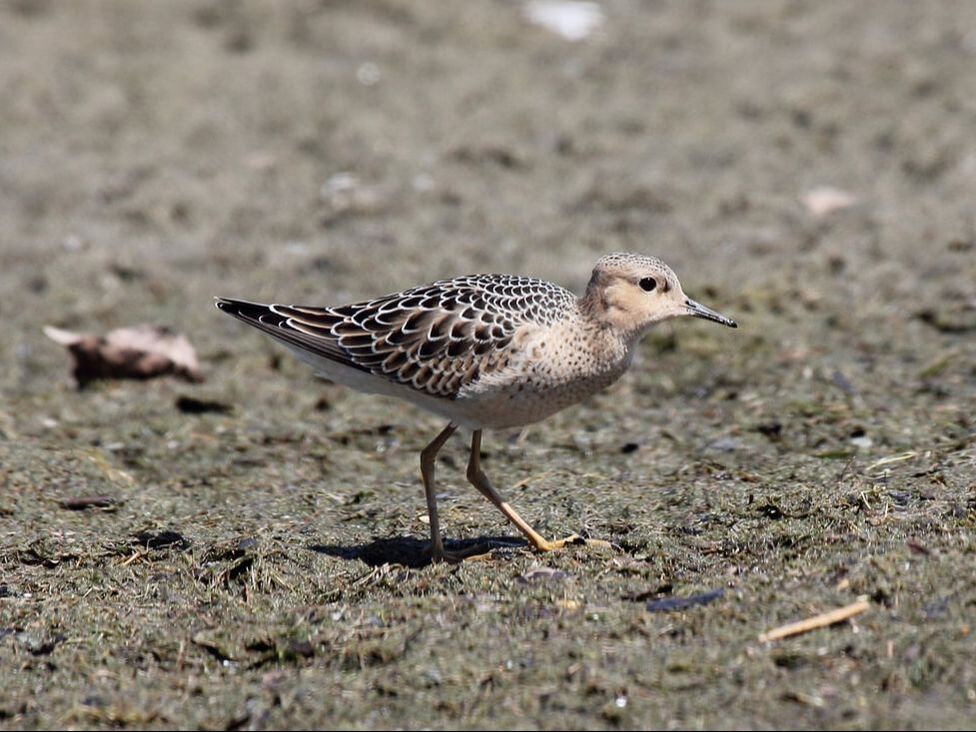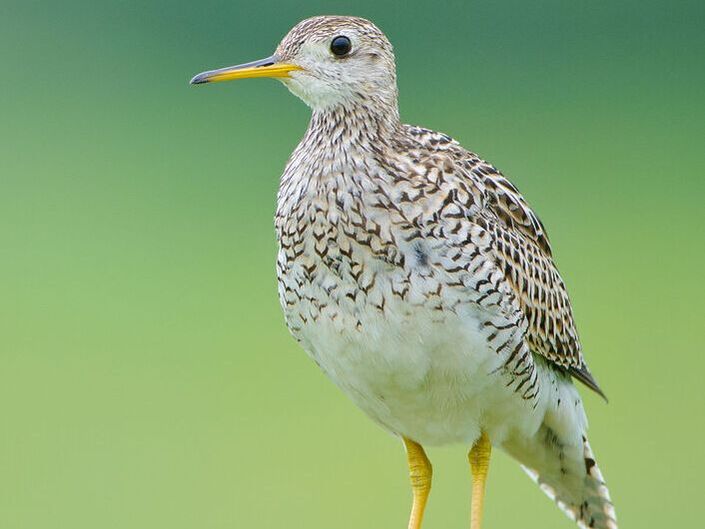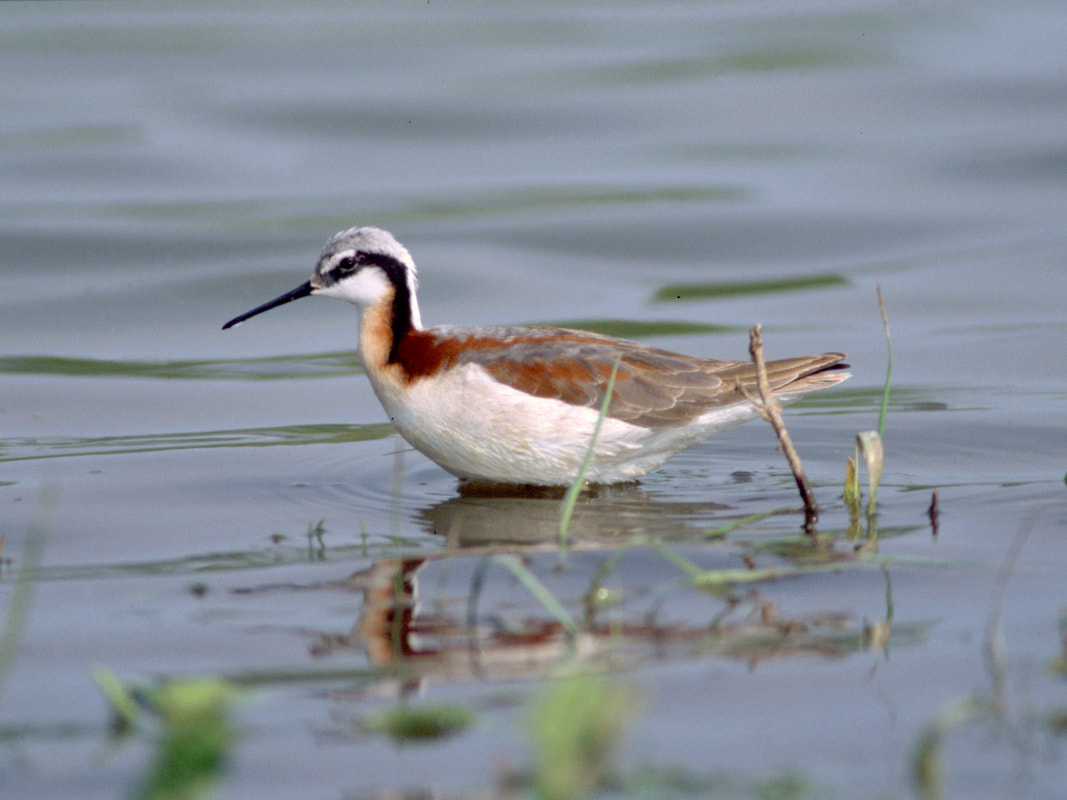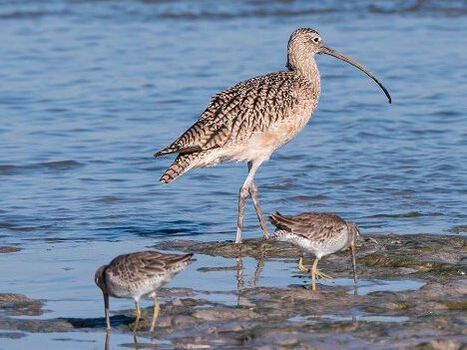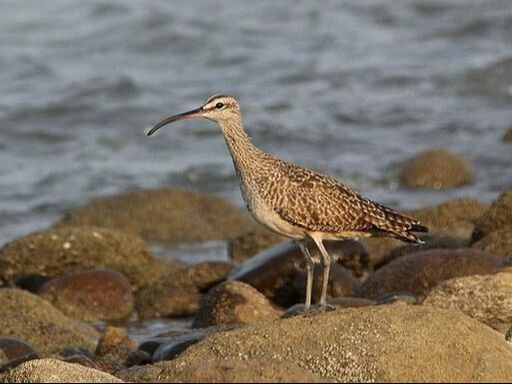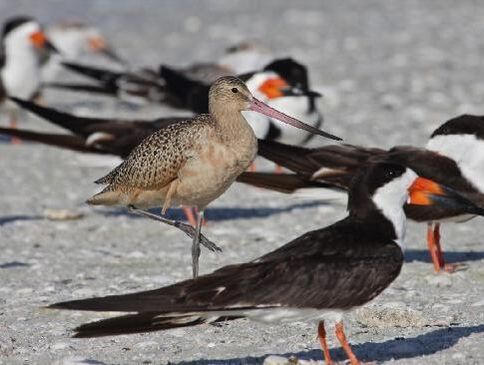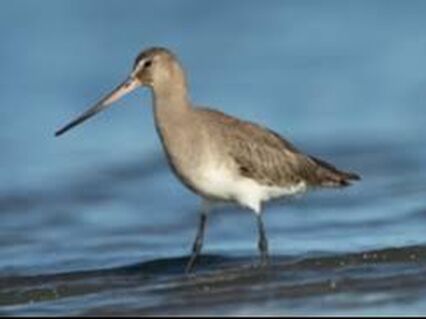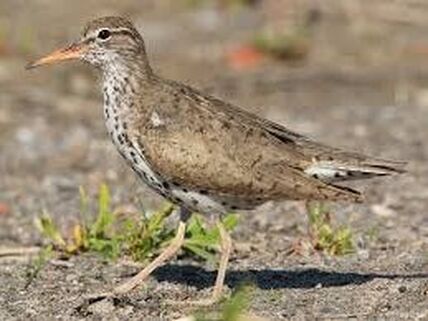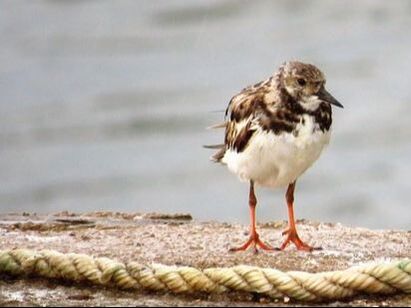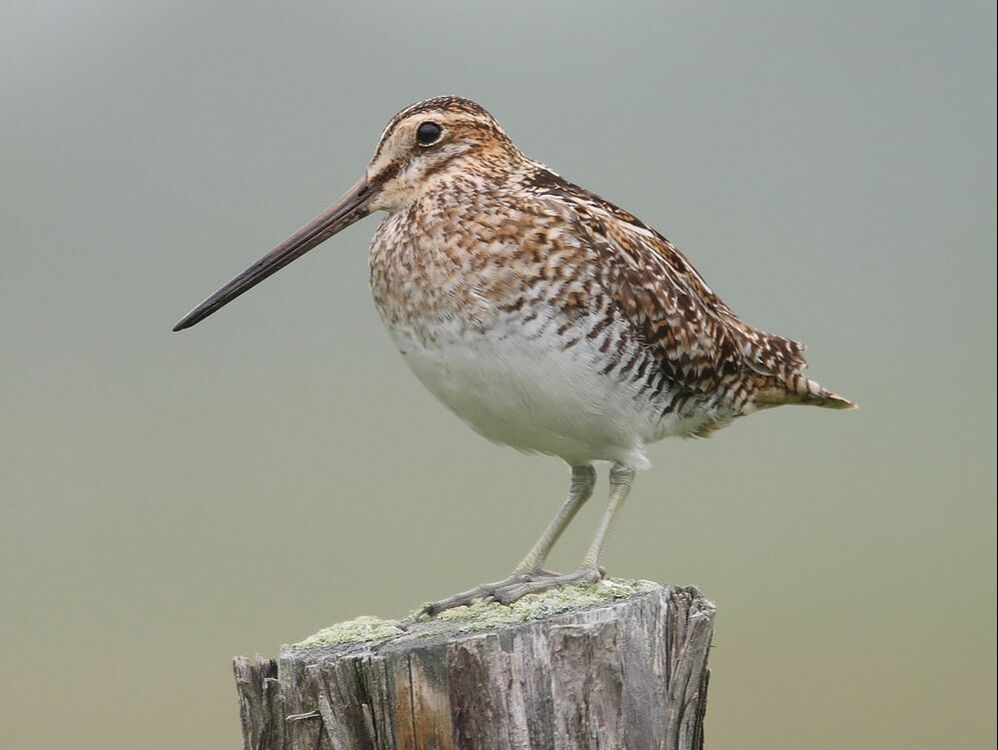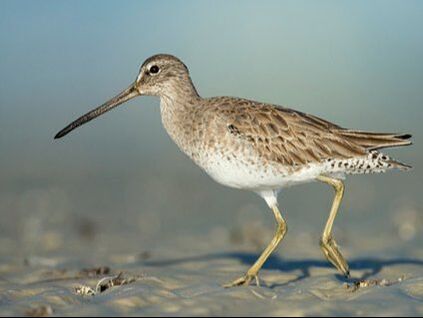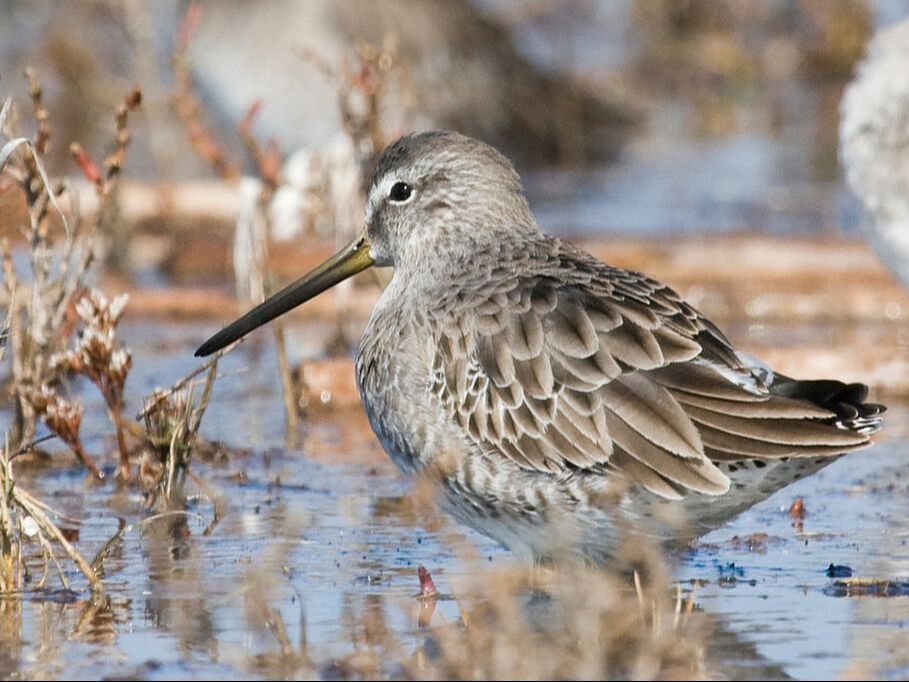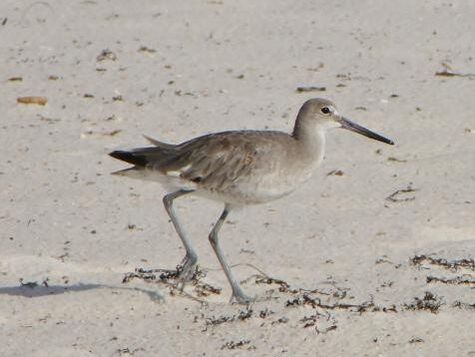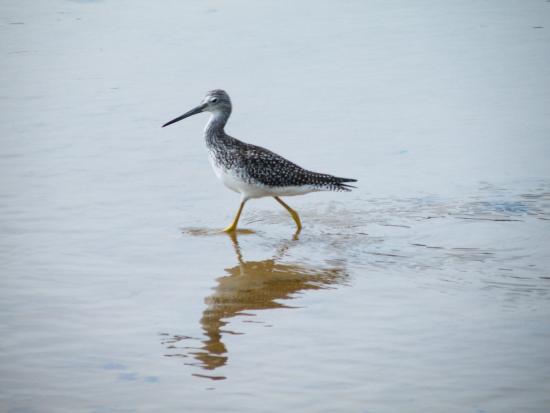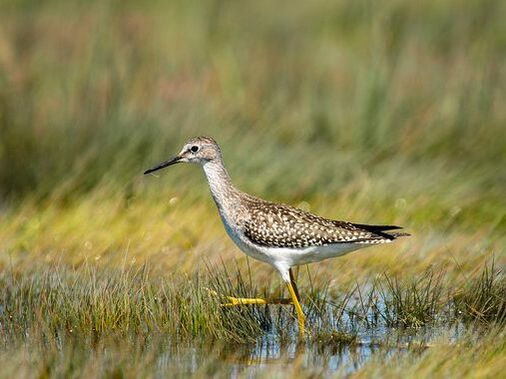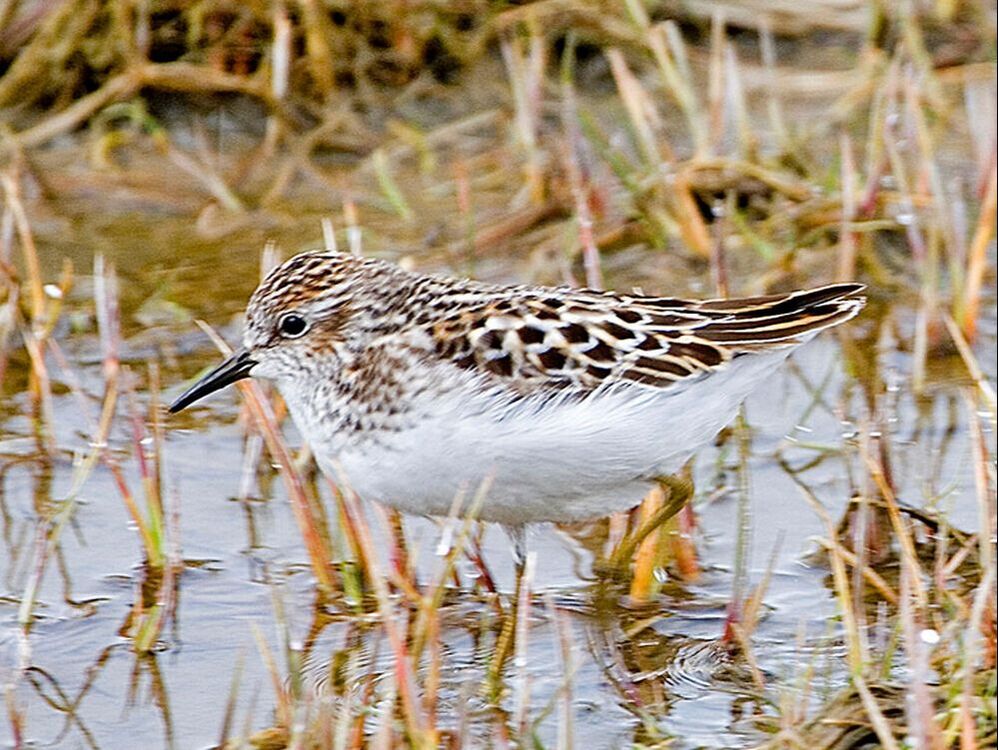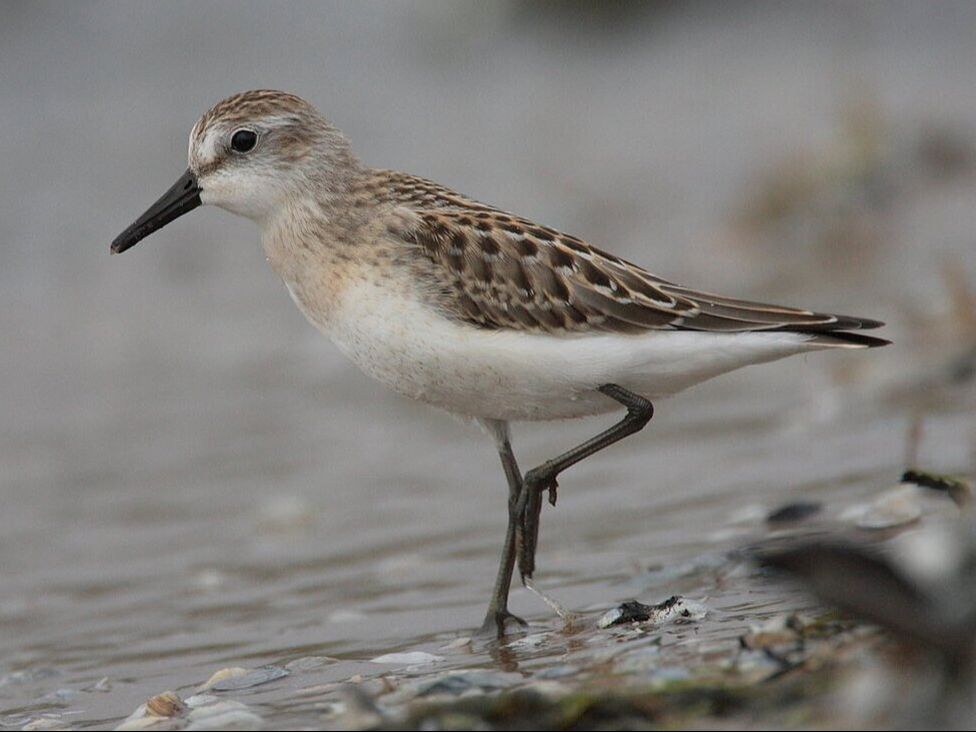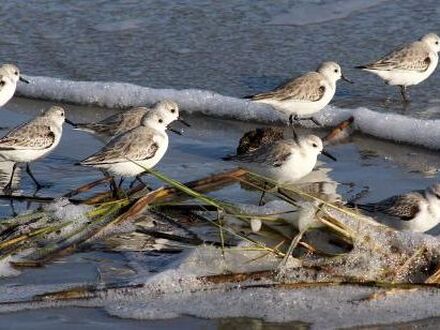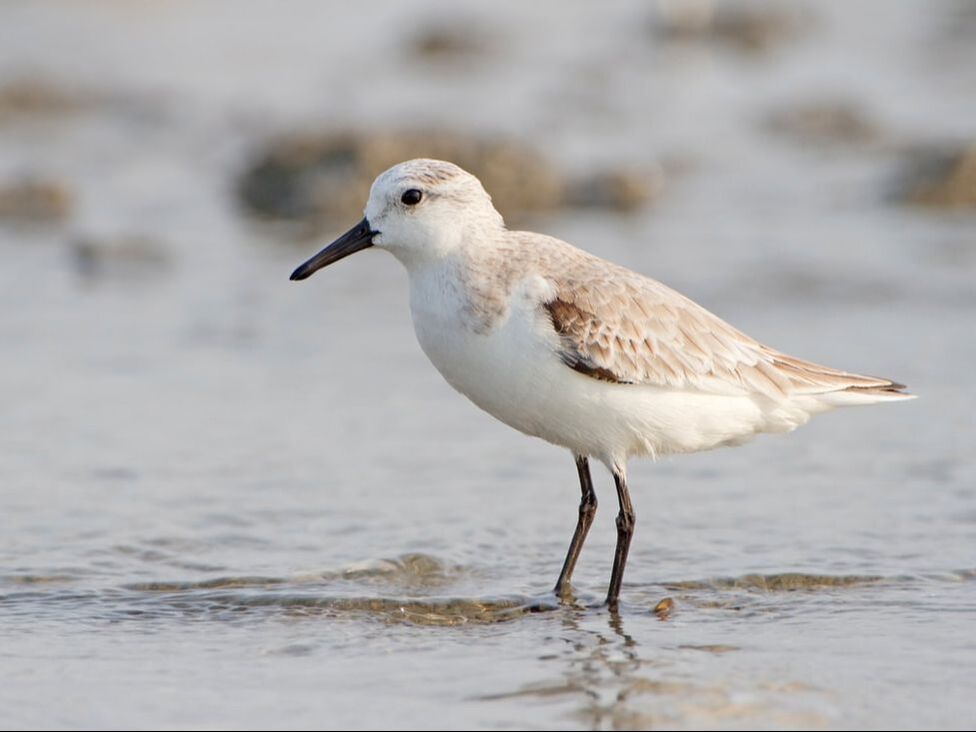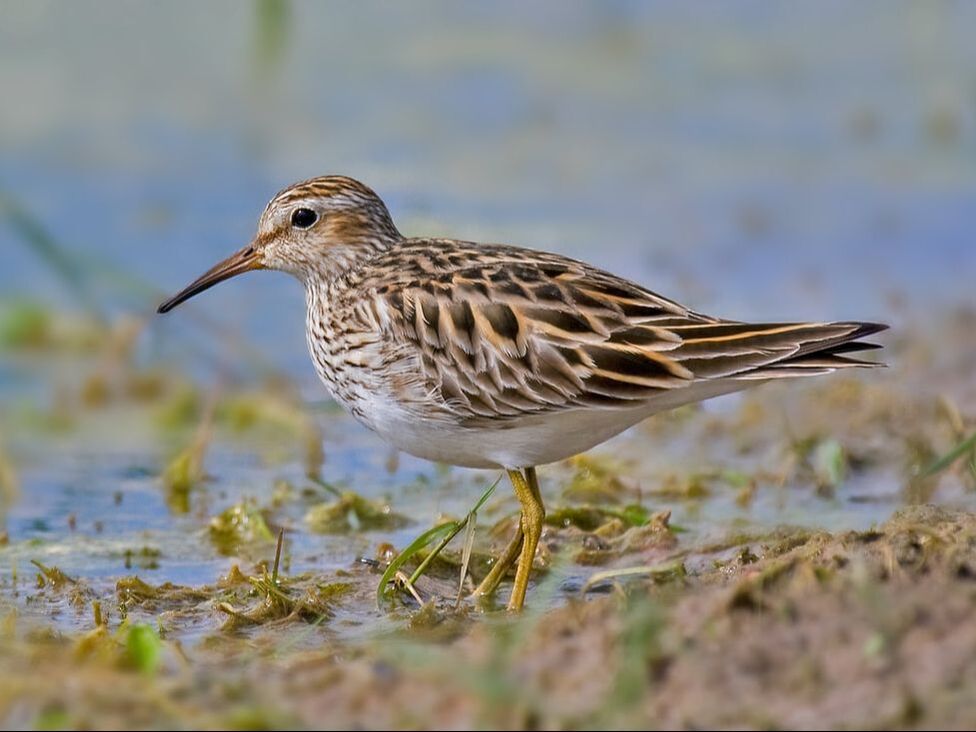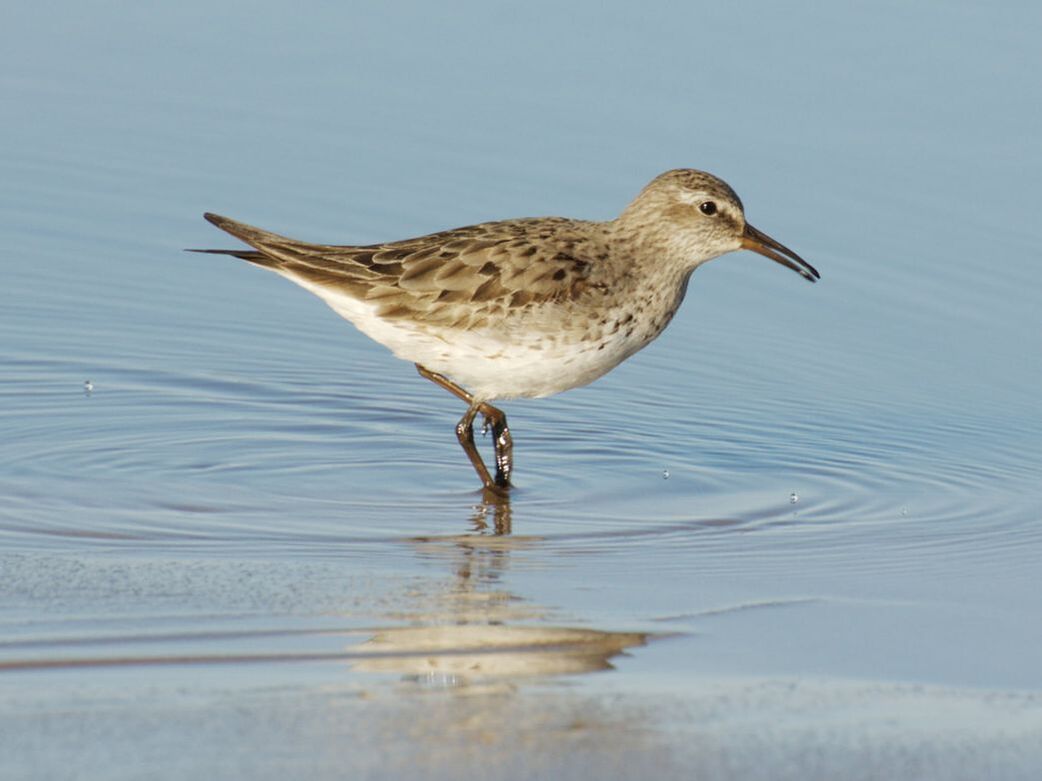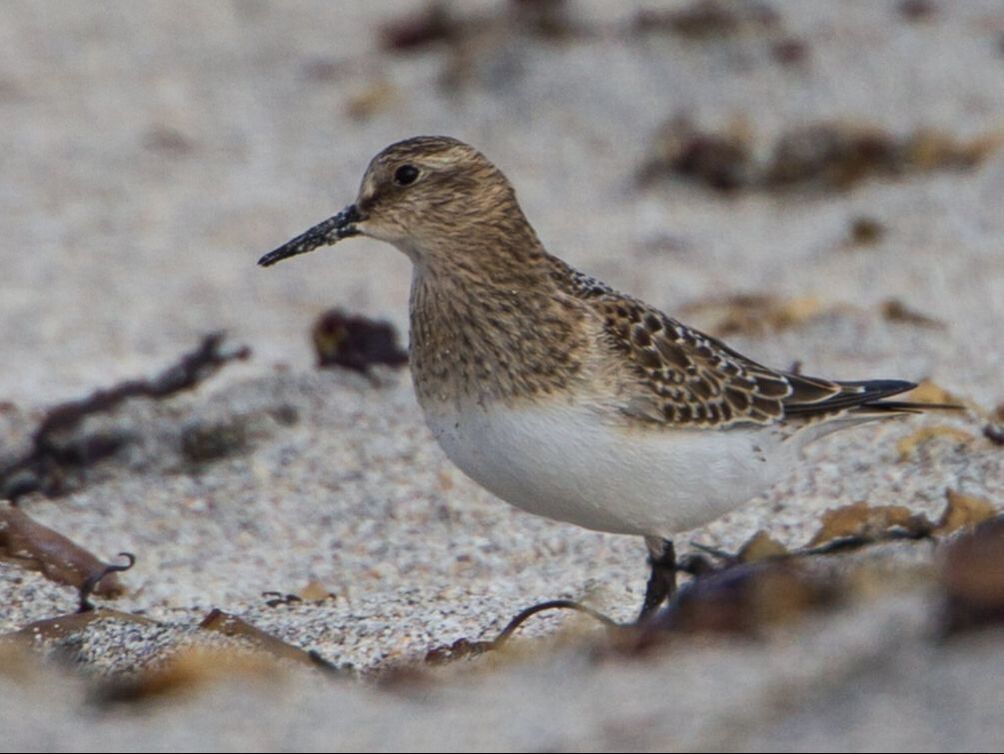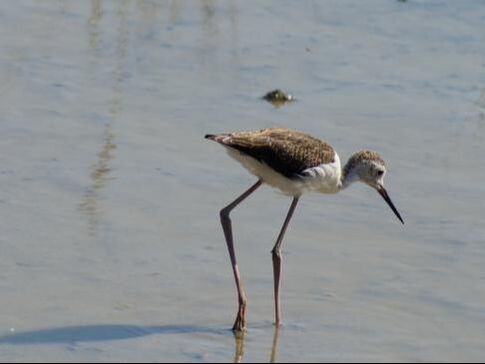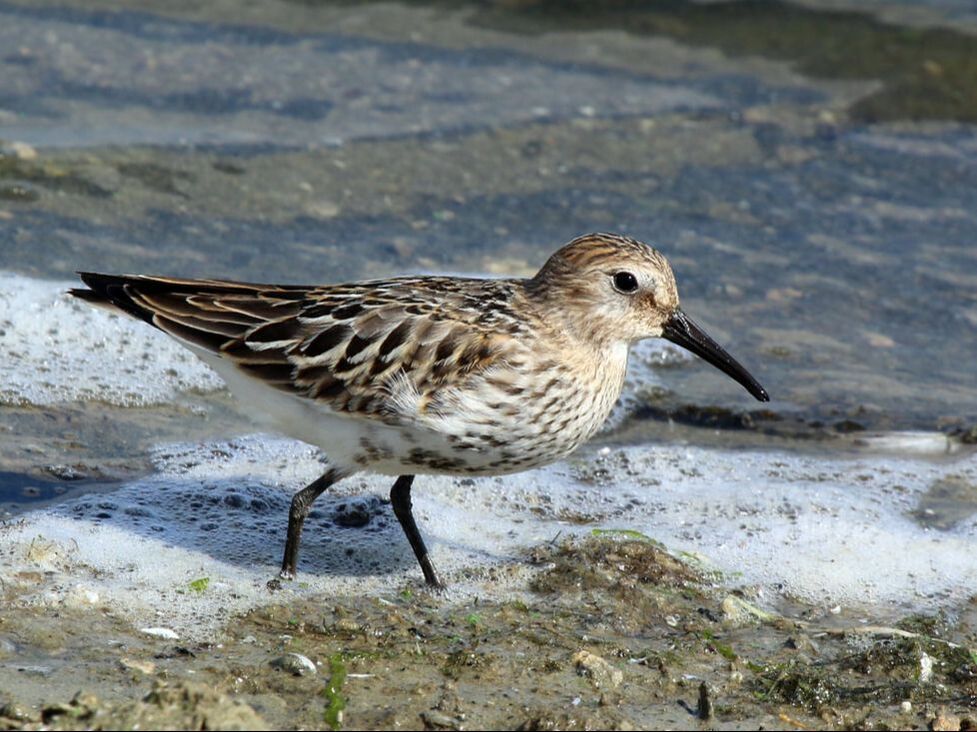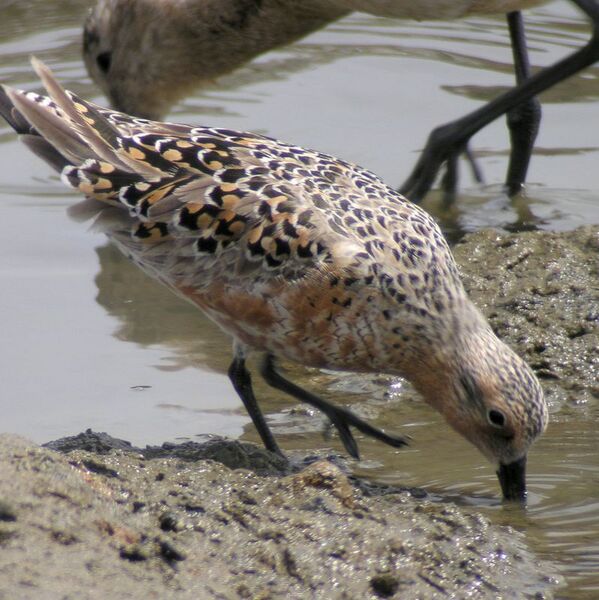Sandpipers - in Belize
Buff-Breasted Sandpiper
Buff Breasted Sandpiper - Elegant buffy sandpiper; peaceful-looking with large eye and plain face. Relatively short bill and medium-length yellow legs. Adults and juveniles similar, but juveniles show crisp scaly back pattern. Similar to Baird's Sandpiper but longer yellow legs and more evenly buffy coloration extending onto the belly. Smaller than Upland Sandpiper and lacks extensive dark markings on face, neck, and sides. Breeds on Arctic tundra. During migration, found in dry habitats such as plowed fields, sod farms, and higher areas of beaches. Winters in South America.
BELIZE HABITAT - Newly planted rice fields, wet short grass meadows. Where can I find this bird in Belize? Occasionally spring and autumn transient; thus far recorded from late August to late September and mid-April to early May. Migration period undoubtedly longer than indicated by the few dated records. |
Upland Sandpiper
Upland Sandpiper - Distinctive sandpiper found in areas with short grass. Frequently seen perched on fence posts or atop small shrubs. Overall patterned buffy-brown with small head, long neck, large eye, and yellow bill with black tip. Long tail and shallow fluttery wingbeats give it a unique look in flight. Song typically given in flight; starts with a soft gurgling trill and ends with a loud whistle that rises and falls. Migrates to South America in the winter, particularly Paraguay and northern Argentina.
BELIZE HABITAT - Drying rice fields, agricultural lands, pasturelands. Often perches on exposed tree snags and fence posts. Where can I find this bird in Belize? Occasionally spring and regular autumn transient, mid-March to mid to late May; late July to early October. |
Wilson's Phalarope
Wilson's Phalarope - Slender shorebird known for spinning on water and feeding on small invertebrates that are stirred up. Females much brighter than males with gray cap, black stripe through the eye and side of neck, peachy-orange neck, and gray-and-rufous back. Males are duller with pale gray upperparts, orangey neck, and white throat. Nonbreeding birds are pale gray above and white below. Look for thin, needlelike bill to help separate from other phalaropes. Prefers shallow, freshwater ponds. Very active. Regularly gathers in large flocks.
BELIZE HABITAT - Lagoons, shrimp farms. Where can I find this bird in Belize? Regular spring and autumn transient. Only three records: Nova Shrimp Farm Toledo on Sept. 20, 1997; Crooked Tree Belize on April 30 1999 (three individuals); and Ambergris Caye on May 14, 1999. |
Long-Billed Curlew
Long Billed Curlew - Huge shorebird with incredibly long, downturned bill used to probe into mud and snag invertebrates. Buffy overall with brighter cinnamon wings. Found on beaches and open fields, solo or in flocks. Exceptional bill length and shape rules out other large shorebirds (Marbled Godwit, Willet and Whimbrel). Lacks dark stripes on head prominent on Whimbrel.
BELIZE HABITAT - Rice fields, freshwater and brackish marshes, wet meadows, shrimp farms. Where can I find this bird in Belize? Regular migrant and winter visitor, late August to mid-May. |
Whimbrel
Whimbrel - Large, brown shorebird with long, decurved bill. Medium-brown plumage with distinctive stripes on head and cold brown (not warm buffy) body and wings. Prefers coastal marshes and mudflats; sometimes on beaches. Often mixes with other large shorebirds. Call a long series of short, shrill whistles.
BELIZE HABITAT - Beaches, sandflats and mudflats. Where can I find this bird in Belize? Uncommon and local winter visitor along mainland coast and cayes primarily from early July to mid-April; occasionally remaining through summer. |
Marbled Gogwit
Marbled Gogwit - Large shorebird with exceptionally long bill that is pink at the base and slightly upturned at the end. Buffy overall with brighter cinnamon underwings. Probes into mud to pull up invertebrates. Favors shallow water wetlands, often in flocks with other large shorebirds like Willet and Whimbrel. Breeds in grasslands.
BELIZE HABITAT - Shrimp farms, sandflats and mudflats, beaches. Where can I find this bird in Belize? Regular winter visitor on mainland coast and cayes, August to March. |
Hudsonian Godwit
Hudsonian Godwit - The smallest godwit, overall rather dark. Long upturned bill, red at the base with a black tip. Breeding male shows rich rufous belly and messy black, gray, and white pattern on back. Female duller. Nonbreeding birds are overall plain gray, but juveniles have more cinnamon tones. Note white eyebrow in all plumages. Most distinctive field mark is black underwing, only seen in flight. Breeds on grassy tundra in Canada and Alaska, winters in southern South America. In migration, found in flooded fields, beaches, mudflats, and shallow marshy pools, sometimes in mixed flocks with Willet or yellowlegs.
BELIZE HABITAT - Lagoons, rice fields, shrimp farms. Where can I find this bird in Belize? Two records: Crooked Tree Belize on May 4, 1986; Aqua Mar Shrimp Farm Toledo on May 16, 1999 (four individuals). |
Spotted Sandpiper
Spotted Sandpiper - Small shorebird. Constantly bobs its tail while working edges of streams, ponds, and lakes for invertebrates. Several individuals may be found at the same body of water, but never forms tight flocks. Underparts spotted in summer; plain in winter. Listen for two- or three-noted whistled call as they flush from shorelines. Distinctive wingbeats: snappy and below horizontal.
BELIZE HABITAT - Rice fields, farm ponds, lagoons, streamsides, shrimp farms, mudflats, and sandflats, beaches. Where can I find this bird in Belize? Common and widespread winter visitor, mid-July to early June. |
Ruddy Turnstone
Ruddy Turnstone - Fairly small, stocky shorebird. Short, pointed bill. Distinctive plumage; in spring and summer, shows bold black-and-white face pattern, bright rufous-and-black wings, and orange legs. Duller brown in winter but still shows shadow of distinct facial pattern and dark breast. Interesting behavior of flipping over rocks, shells, and debris to nab invertebrates. Walks along beaches, jetties and piers.
BELIZE HABITAT - Sandy beaches with seaweed or coral rubble; shrimp farms; occasionally lagoons. Where can I find this bird in Belize? Common winter visitor on cayes, locally fairly common winter visitor on mainland coast, early July to late May (a few year round); recorded in land occasionally at Crooked Tree in migration. |
Wilson's Snipe
Wilson's Snipe - Plump, camouflaged shorebird that blends into wet meadows and marshy areas. Similar in shape to American Woodcock but much darker, with brown markings on underparts and striped face. Exceptionally long bill is used for probing into mud. On breeding grounds, watch and listen for aerial flight display, which includes a rapid series of hoot-like noises produced by the outer tail feathers.
BELIZE HABITAT - Wet drainage ditches, muddy pastures, marshes, rice fields, vegetated edge of mudflats. Where can I find this bird in Belize? Uncommon to locally fairly common winter visitor, mid-September to early April. |
Long-Billed Dowitcher
Long Billed Dowitcher - Plump, long-billed shorebird. Breeding adults have salmon-orange underparts with thin black and white bars on neck and sides. Very similar to Short-billed Dowitcher. Upperparts are darker than Short-billed Dowitcher; feathers have darker rufous markings and narrower white tips. Nonbreeding adult plain gray; plumage nearly identical to Short-billed. Juvenile plain brownish-gray, generally duller than Short-billed; upper wing feathers edged with rufous, lacking bright golden markings. Best separated from Short-billed Dowitcher by voice: a sharp "keek" note, sometimes given in a series, unlike lower-pitched "tututu" call of Short-billed. Also taller and more rotund than Short-billed, especially noticeable when in mixed flock. Breeds in Arctic tundra; migrates and winters in a variety of wetland habitats, especially shallow marshy pools. More likely around freshwater than Short-billed, but much overlap.
BELIZE HABITAT - Freshwater marshes, mudflats. Where can I find this bird in Belize. Uncommon to locally fairly common winter visitor, late August to late April; most often seen at Blue Creek rice fields and shrimp farms, where shorebirds congregate in large numbers. This is the expected dowitcher at inland sites in winter. |
Short-Billed Dowitcher
Short Billed Dowitcher - Medium-sized, plump shorebird with long bill. Found in a variety of wet habitats, but generally prefers saltwater marshes, beaches, and mudflats. Breeding birds are intricately patterned; generally dark with gold spangles above and orange below. Sides are barred, not spotted like Long-billed Dowitcher, otherwise extremely similar to Long-billed in all plumages, especially winter when both species are plain gray. Long-billed tends to favor freshwater habitats, but much overlap. Most obvious difference is voice; Short-billed gives rapid series of notes "tu-tu-tu" unlike single piercing "keek!" of Long-billed.
BELIZE HABITAT - Coastal lowlands; shrimp farms, estuaries, sandflats and mudflats; occasionally marshes. Where can I find this bird in Belize? Uncommon to locally common transient and winter visitor in coastal areas and on the cayes, early July to late April. Often seen inland in migration; however, dowitchers seen away from the coast in winter are likely to be long-billed. |
Willet
Willet - Large shorebird most often seen towering above Sanderlings on coastal beaches. Bill is relatively thick and longer than the head. Plain gray overall with more barring in summer. Very distinctive black-and-white wing pattern. Bluish-gray legs. Two subspecies; "Eastern" breeds in saltmarshes along East Coast of U.S.; "Western" breeds in marshy grasslands in the Interior West.
BELIZE HABITAT - Beaches, shrimp farms. Where can I find this bird in Belize? Uncommon winter visitor on cayes and mainland coast, early July to mid-May. Once inland at Hill Bank Orange Walk on March 30, 1955. On mainland, most often seen at shrimp farms, where sometimes fairly common during migration. |
Greater Yellowlegs
Greater Yellowlegs - Medium-large shorebird with bright yellow legs. Plumage is essentially identical to Lesser Yellowlegs; gray upperparts with white speckling, and white belly. Proportions are more important for separating two species; bill longer than the head and slightly upturned. Larger overall size than Lesser Yellowlegs with longer neck, blockier head, and bigger chest. Forages actively on mudflats and shallow water areas, taking long strides and reaching down to snatch invertebrates. See also: Lesser Yellowlegs.
BELIZE HABITAT - Freshwater marshes, rice fields, shrimp farms, sandflats and mudflats. Where can I find this bird in Belize? Fairly common to common winter visitor on mainland, less common on cayes, mid-July to mid-May, occasionally through summer. |
Lesser Yellowlegs
Lesser Yellowlegs - Medium-sized shorebird with bright yellow legs. Plumage is essentially identical to Greater Yellowlegs; gray upperparts with white speckling, and white belly. Proportions are more important: bill only slightly longer than the head and straight; smaller overall than Greater Yellowlegs with shorter neck, rounded head, and cuter appearance. See also: Greater Yellowlegs.
BELIZE HABITAT - Similar to Greater Yellowlegs. Where can I find this bird in Belize? Fairly common to locally common winter visitor mid-July to mid-May; infrequent on cayes. |
Solitary Sandpiper
Solitary Sandpiper - Often alone. Smaller than Lesser Yellowlegs, with greener legs. Generally gray above and white below, with fine white speckling on wings and usually distinctive white spectacles. Tips body like Spotted Sandpiper, but movement isn't as quick and dramatic. Spring migration is short and fast, more likely to be seen in fall in the continental U.S. Winters in Central and South America.
BELIZE HABITAT - Freshwater marshes, rice fields, small ponds, streamside. Where can I find this bird in Belize? Fairly common winter visitor, late July to early May. |
Least Sandpiper
Least Sandpiper - Smallest shorebird; sparrow-sized but with longer wings. Falls into category called "peeps." Darkest, brownest "peep," especially on the back. Yellow-green legs can be muddy and darkened, but otherwise a safe clue for separating from other small shorebirds. Breeds on arctic tundra.
BELIZE HABITAT - Shrimp farms, rice fields, sandflats and mudflats, lagoons, estuaries, beaches. Where can I find this bird in Belize? Common resident and winter visitor in coastal lowlands and cayes, mid-July to late May, but uncommon and local in winter in interior. |
Semi-Palmated Sandpiper
Semi-Palmated Sandpiper - Small shorebird, falls into group called "peeps." Most similar to Least and Western Sandpiper. Shorter, blunter bill than Western without rufous tones in summer. Paler and grayer-brown than Least. Often in large flocks on mudflats, sometimes beaches. Winters in South America; very rarely lingers in the U.S., unlike Western Sandpiper. Breeds on arctic tundra. Seen in the continental U.S. only during migration.
BELIZE HABITAT - Shrimp farms, rice fields, sandflats and mudflats. Where can I find this bird in Belize? Locally common autumn transient, fairly common spring transient, and occasionally winter visitor in coastal lowlands, early August to late May, but with few records between mid-October and early March; relatively few records from cayes. Most common in August, when it sometimes outnumbers Western. Because of its close similarity to Western especially in basic plumage, birds seen in winter should be carefully documented. |
Western Sandpiper
Western Sandpiper - Small shorebird, falls into category called "peeps." Longer, droopier bill than Semipalmated Sandpiper, with larger head and more front-heavy shape. In summer, shows rich rufous tones on shoulders, cheeks, and crown. Pale gray above in winter. Often in large flocks on coastal mudflats and beaches. More common in the western U.S. than the east. Occurs in winter in the U.S., unlike Semipalmated Sandpiper; also found in coastal South America.
BELIZE HABITAT - Shrimp farms, rice fields, sandflats and mudflats; occasionally beaches. Where can I find this bird in Belize? Locally common to very common autumn transient in coastal lowlands and cayes, less common in winter and spring; late July to mid-May. As with most other shorebirds, congregates at shrimp farms, where a thousand or more can be seen on some days in autumn. After August, generally out numbers Semipalmated by one to two orders of magnitude. |
Sanderling
Sanderling - Small, sprightly shorebird, often seen in small flocks running back and forth as if chasing the waves. Gray and white in fall and winter; in this plumage, paler than other similarly sized shorebirds. Acquires rusty red tones on head and breast in spring. Juveniles in fall are boldly spangled black-and-white above. Breeds on the tundras of the High Arctic and winters on coastal mudflats and beaches; can also be found along the shorelines of large lakes during migration.
BELIZE HABITAT - Sandy beaches, shrimp farms. Where can I find this bird in Belize? Locally fairly common winter visitor on cayes and mainland coast south to northeast Toledo, early August to early May. |
Pectoral Sandpiper
Pectoral Sandpiper - Among the small "peep" sandpipers, this is a beefy shorebird seen more often in wet grass than sand or water. Combination of larger size, yellowish legs, and brownish bill base is usually enough to separate from other sandpipers; also look for dense breast streaking with abrupt border at white belly. Upperparts brown with rufous tinge. Plumage and yellow legs similar to Least Sandpiper but much larger. Males have large air sac in throat, which they inflate during display.
BELIZE HABITAT - Rice fields, shrimp farms, marshes, lagoons. Where can I find this bird in Belize? Fairly common autumn and spring transient, mid-August to early October and early March to late May. |
White-Rumped Sandpiper
White Rumped Sandpiper - Long-winged sandpiper most easily identified by size and shape. Slightly larger than other small sandpipers; noticeably elongated body and long wingtips. Distinctive white rump visible in flight. In breeding plumage, crisply spangled black and brown wings; note warmer brown cheek and crown and extensive fine streaking on sides. Nonbreeding plumage is plainer gray with pale eyebrow; typically shows some streaking on sides well into the fall. Juvenile bright and crisp; note pale eyebrow and long wings. In all plumages, shows brownish base to the lower mandible, only visible at close range. Most similar to Baird's Sandpiper but grayer. Found on mudflats, shallow marshy pools, and flooded fields; often mixed with other small shorebirds. Short, high-pitched, metallic call usually given in flight or when alarmed.
BELIZE HABITAT - Rice fields, lagoons, shrimp farms. Where can I find this bird in Belize? Common spring transient in coastal lowlands and cayes, mid-April to early June. One autumn record on October 18, 1996, Nova Shrimp Farm Belize. Numbers peak in mid-May after most other shorebirds have departed. |
Baird's Sandpiper
Baird's Sandpiper - Long-winged, long-distance migrant similar to White-rumped Sandpiper but with warmer buffy-tan plumage. Elongated body gives a horizontal impression when foraging; unique flattened oval shape when seen head-on. Black bill and brown rump. Breeding adults rather pale with large black spots on back. Crisp juveniles show neat scaly pattern on wings and back and have a warm buffy face and neck. Often with flocks of other small shorebirds, but prefers drier habitats, such as the grassy edge of a mudflat, seaweed-covered upper portion of a beach, or sod field. Breeds in the Arctic tundra; winters in South America.
BELIZE HABITAT - Usually found in the drier, upper portion of marshes and mudflats with sparse low grasses, away from water. Where can I find this bird in Belize? Not yet confirmed but probably a very regular spring (and autumn) transient. |
Stilt Sandpiper
Stilt Sandpiper - Long-legged, long-billed shorebird. Often found with dowitchers or yellowlegs in muddy, marshy pools. Breeds in Arctic tundra. Breeding adults are barred black and white, with white eyebrows and rufous cheeks. Nonbreeding birds are pale gray with whitish bellies and white eyebrows. Juveniles have scaly wings and buffier tones on the neck and head. At all times, note dull, yellowish-green legs and long, droopy bill. In flight, note white rump.
BELIZE HABITAT - Rice fields, shrimp farms. Where can I find this bird in Belize? Uncommon to locally fairly common transient and occasional winter visitor on mainland, mid-august to mid-May. Occasionally on Ambergris Caye. |
Dunlin
Dunlin - Smallish shorebird, slightly larger than stints and “peeps,” with a long bill that droops slightly at the end. Breeding plumage is distinctive with bright rufous back and black belly. In fall and winter, Grayish-brown above with paler belly. Often in large flocks on mudflats and beaches, occasionally mixing with other shorebirds. Gives loud, high, slightly buzzy “weep” and “cheep” calls.
BELIZE HABITAT - Beaches, shrimp farms, coastal lagoons. Where can I find this bird in Belize? Three acceptable records: Commerce Bight near Dangriga Stann Creek on March 21, 1990 (three individuals); Aqua Mar Shrimp Farm Toledo on January 6, 1999; and Nova Shrimp Farm Belize on December 17, 2000. |
Red-Knot Sandpiper
Red Knot Sandpiper - Stocky shorebird with short, thick bill and legs. Breeding plumage distinctive with entirely salmon-orange underparts and pearly gray wings. Nonbreeding and juvenile plain gray with barring on sides and diffuse pale eyebrow. Legs greenish. Most similar to nonbreeding Sanderling and Dunlin. Darker gray and larger bodied than Sanderling. Larger bodied and shorter billed than Dunlin. Feeds on a variety of small invertebrates; West Atlantic population reliant on horseshoe crab eggs during spring migration. Most common on beaches and mudflats; less common inland. Often in mixed flocks with other shorebirds.
BELIZE HABITAT - Shrimp farms, beaches. Where can I find this bird in Belize? Uncommon and local migrant and winter visitor along central mainland coast; once each on Caye Caulker and Ambergris Caye. Recorded only from early September to early March. Most records are from shrimp farms and Dangriga. |

